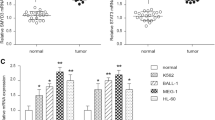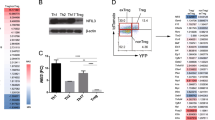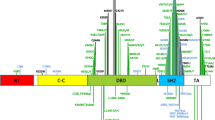Abstract
The signal transducers and activators of transcription (STATs) have diverse biological functions and are involved in cell differentiation, proliferation, development, apoptosis and inflammation. Several constitutively activated STATs have been observed in a wide variety of human cancer cell lines and primary tumor cells, including blood malignancies and solid neoplasias. Although regulatory T (Treg) cells induce immune tolerance by suppressing host immune responses against self- or nonself-antigens, thus playing critical roles in preventing autoimmune diseases, they might inhibit antitumor immunity and promote tumor growth. Our previous findings suggest that the supernatant from STAT4-silenced tumor cell culture can significantly increase the ratio of CD4+ CD25+ Foxp3+ regulatory T cells among splenic cells in vitro, when compared to that from normal tumor cell culture. In the present study, we identified that the mouse lymphoma cell line EL-4 expressed a high level of STAT4, and silencing of STAT4 by siRNA did not change the expression levels of TGF-β and IL-10 in EL-4 cells. Two-dimensional electrophoresis was conducted to examine the difference of expression profiles of proteins between normal and STAT4-silenced EL4 cells. Some of the protein which has been changed may induce CD4+ CD25+ Foxp3+ regulatory T cells in vitro.
Similar content being viewed by others
References
Pfeifer A C, Timmer J, Klingmüller U. Systems biology of JAK/STAT signaling. Essays Biochem, 2008, 45: 109–120
Wuest T Y, Willette-Brown J, Durum S K, et al. The influence of IL-2 family cytokines on activation and function of naturally occurring regulatory T cells. J Leukoc Biol, 2008, 84: 973–980
Mitchell T J, John S. Signal transducer and activator of transcription (STAT) signaling and T-cell lymphomas. Immunology, 2005, 114: 301–312
Kim H S, Lee M S. STAT1 as a key modulator of cell death. Cell Signal, 2007, 19: 454–465
Uddin S, Platanias L C. Mechanisms of type-I interferon signal transduction. J Biochem Mol Biol, 2004, 37: 635–641
Schindler C, Levy D E, Decker T. JAK-STAT signaling: From interferons to cytokines. J Biol Chem, 2007, 282: 20059–20063
Wurster A L, Tanaka T, Grusby M J. The biology of Stat4 and Stat6. Oncogene, 2000, 19: 2577–2584
WANG R F. Regulatory T cells and innate immune regulation in tumor immunity. Springer Semin Immun, 2006, 28: 17–23
Wang Y, LI Y H, LI X J, et al. Functional analysis of STAT 4 in tumor immunity by inhibitory JAK/STAT in vitro (in Chinese). Acta Scient Nat Univ Nankaiensis (Nat Sci Ed), 2007, 40:102–105
Liu V C, Wong L Y, Jang T, et al. Tumor Evasion of the Immune System by Converting CD4+ CD25− T Cells into CD4+ CD25+ T Regulatory Cells: Role of Tumor-Derived TGF-β. J Immunol, 2007, 178: 2883–2892
Horwitz D A, Zheng S G, Gray J D. The role of the combination of IL-2 and TGF-β or IL-10 in the generation and function of CD4+ CD25+ and CD8+ regulatory T cell subsets. J Leukoc Biol, 2003, 74: 471–478
Sugawara I, Yamada H, Mizuno S. Relative importance of STAT4 in murine tuberculosis. J Med Microbiol, 2003, 52: 29–34
Suto A, Nakajima H, Tokumasa N, et al. Murine plasmacytoid dendritic cells produce IFN-γ upon IL-4 stimulation. J Immunol, 2005, 175: 5681–5689
Boyton R J, Davies S, Marden C, et al. Stat4-null non-obese diabetic mice: protection from diabetes and experimental allergic encephalomyelitis, but with concomitant epitope spread. Int Immunol, 2005, 17: 1157–1165
Arya M, Shergill IS, Williamson M, et al. Basic principles of realtime quantitative PCR. Expert Rev Mol Diagn, 2005, 5: 209–219
Fehervari Z, Sakaguchi S. Development and function of CD25+ CD4+ regulatory T cells. Curr Opin Immunol, 2004, 16: 203–208
Schabowsky R H, Madireddi S, Sharma R, et al. Targeting CD4+ CD25+ FoxP3+ regulatory T cells for the augmentation of cancer immunotherapy. Curr Opin Investig Drugs, 2007, 8: 1002–1008
Ralainirina N, Poli A, Michel T, et al. Control of NK cell functions by CD4+ CD25+ regulatory T cells. J Leukoc Biol, 2007, 81: 144–153
Sakaguchi S, Yamaguchi T, Nomura T, et al. Regulatory T cells and immune tolerance. Cell, 2008, 133: 775–787
Grant L R, Yao Z J, Hedrich C M, et al. Stat4-dependent, T-bet-independent regulation of IL-10 in NK cells. Genes Immun, 2008, 9: 316–327
Collison L W, Workman C J, Kuo T T, et al. The inhibitory cytokine IL-35 contributes to regulatory T-cell function. Nature, 2007, 450: 566–569
Author information
Authors and Affiliations
Corresponding author
Additional information
Supported by the National Key Basic Research and Development Program of China (Grant No. 2007CB914804), National High Technology Research and Development Program of China (Grant No. 2007AA021010), Foundation of the Ministry of Education of China for Returned Scholars, Key Project of the Science & Technology Pillar Program of Tianjin (Grant No. 07ZCKFSH03700), and Innovative Research Foundation of Nankai University
About this article
Cite this article
Wei, X., Ni, H., Wang, Q. et al. Impact of STAT4 gene silencing on the expression profile of proteins in EL-4 cells. Chin. Sci. Bull. 54, 3265–3270 (2009). https://doi.org/10.1007/s11434-009-0468-9
Received:
Accepted:
Published:
Issue Date:
DOI: https://doi.org/10.1007/s11434-009-0468-9




